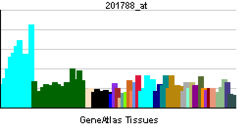- DDX42
-
DEAD (Asp-Glu-Ala-Asp) box polypeptide 42 Identifiers Symbols DDX42; FLJ43179; RHELP; RNAHP; SF3b125 External IDs OMIM: 613369 MGI: 1919297 HomoloGene: 49137 GeneCards: DDX42 Gene EC number 3.6.4.13 Gene Ontology Molecular function • nucleotide binding
• RNA binding
• helicase activity
• protein binding
• ATP binding
• ATP-dependent helicase activity
• hydrolase activityCellular component • nucleus
• nucleolus
• cytoplasm
• Cajal body
• nuclear speckBiological process • protein localization
• regulation of anti-apoptosisSources: Amigo / QuickGO RNA expression pattern 
More reference expression data Orthologs Species Human Mouse Entrez 11325 72047 Ensembl ENSG00000198231 ENSMUSG00000020705 UniProt Q86XP3 n/a RefSeq (mRNA) NM_007372.2 NM_028074.4 RefSeq (protein) NP_031398.2 NP_082350.3 Location (UCSC) Chr 17:
61.85 – 61.9 MbChr 11:
106.08 – 106.11 MbPubMed search [1] [2] ATP-dependent RNA helicase DDX42 is an enzyme that in humans is encoded by the DDX42 gene.[1][2]
This gene encodes a member of the Asp-Glu-Ala-Asp (DEAD) box protein family. Members of this protein family are putative RNA helicases, and are implicated in a number of cellular processes involving alteration of RNA secondary structure such as translation initiation, nuclear and mitochondrial splicing, and ribosome and spliceosome assembly. Members of this family are believed to be involved in embryogenesis, spermatogenesis, and cellular growth and division. Two transcript variants encoding the same protein have been identified for this gene.[2]
Interactions
DDX42 has been shown to interact with SF3B1.[3]
References
- ^ Suk K, Kim S, Kim YH, Oh SH, Lee MK, Kim KW, Kim HD, Seo YS (Jun 2000). "Identification of a novel human member of the DEAD box protein family". Biochim Biophys Acta 1501 (1): 63–9. PMID 10727850.
- ^ a b "Entrez Gene: DDX42 DEAD (Asp-Glu-Ala-Asp) box polypeptide 42". http://www.ncbi.nlm.nih.gov/sites/entrez?Db=gene&Cmd=ShowDetailView&TermToSearch=11325.
- ^ Will, Cindy L; Urlaub Henning, Achsel Tilmann, Gentzel Marc, Wilm Matthias, Lührmann Reinhard (Sep. 2002). "Characterization of novel SF3b and 17S U2 snRNP proteins, including a human Prp5p homologue and an SF3b DEAD-box protein". EMBO J. (England) 21 (18): 4978–88. doi:10.1093/emboj/cdf480. ISSN 0261-4189. PMC 126279. PMID 12234937. http://www.pubmedcentral.nih.gov/articlerender.fcgi?tool=pmcentrez&artid=126279.
Further reading
- Olsen JV, Blagoev B, Gnad F, et al. (2006). "Global, in vivo, and site-specific phosphorylation dynamics in signaling networks". Cell 127 (3): 635–48. doi:10.1016/j.cell.2006.09.026. PMID 17081983.
- Uhlmann-Schiffler H, Jalal C, Stahl H (2006). "Ddx42p—a human DEAD box protein with RNA chaperone activities". Nucleic Acids Res. 34 (1): 10–22. doi:10.1093/nar/gkj403. PMC 1325199. PMID 16397294. http://www.pubmedcentral.nih.gov/articlerender.fcgi?tool=pmcentrez&artid=1325199.
- Gerhard DS, Wagner L, Feingold EA, et al. (2004). "The Status, Quality, and Expansion of the NIH Full-Length cDNA Project: The Mammalian Gene Collection (MGC)". Genome Res. 14 (10B): 2121–7. doi:10.1101/gr.2596504. PMC 528928. PMID 15489334. http://www.pubmedcentral.nih.gov/articlerender.fcgi?tool=pmcentrez&artid=528928.
- Ballif BA, Villén J, Beausoleil SA, et al. (2005). "Phosphoproteomic analysis of the developing mouse brain". Mol. Cell Proteomics 3 (11): 1093–101. doi:10.1074/mcp.M400085-MCP200. PMID 15345747.
- Ota T, Suzuki Y, Nishikawa T, et al. (2004). "Complete sequencing and characterization of 21,243 full-length human cDNAs". Nat. Genet. 36 (1): 40–5. doi:10.1038/ng1285. PMID 14702039.
- Strausberg RL, Feingold EA, Grouse LH, et al. (2003). "Generation and initial analysis of more than 15,000 full-length human and mouse cDNA sequences". Proc. Natl. Acad. Sci. U.S.A. 99 (26): 16899–903. doi:10.1073/pnas.242603899. PMC 139241. PMID 12477932. http://www.pubmedcentral.nih.gov/articlerender.fcgi?tool=pmcentrez&artid=139241.
- Will CL, Urlaub H, Achsel T, et al. (2002). "Characterization of novel SF3b and 17S U2 snRNP proteins, including a human Prp5p homologue and an SF3b DEAD-box protein". EMBO J. 21 (18): 4978–88. doi:10.1093/emboj/cdf480. PMC 126279. PMID 12234937. http://www.pubmedcentral.nih.gov/articlerender.fcgi?tool=pmcentrez&artid=126279.
Categories:- Human proteins
- Chromosome 17 gene stubs
Wikimedia Foundation. 2010.
